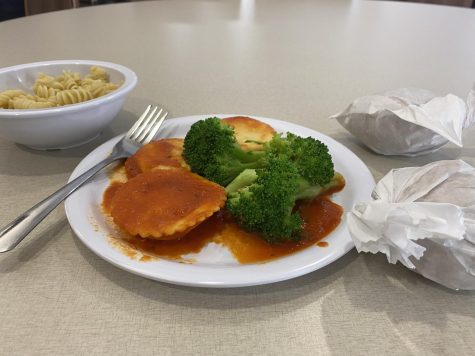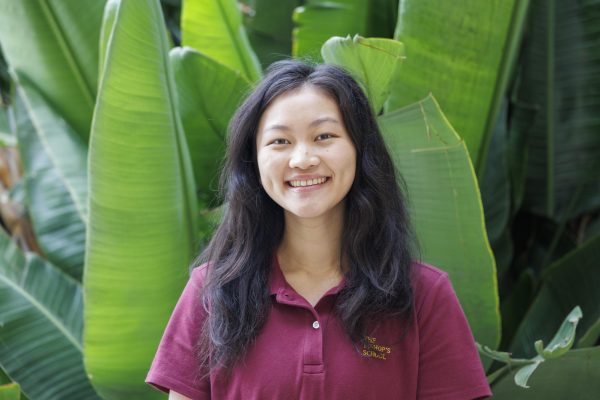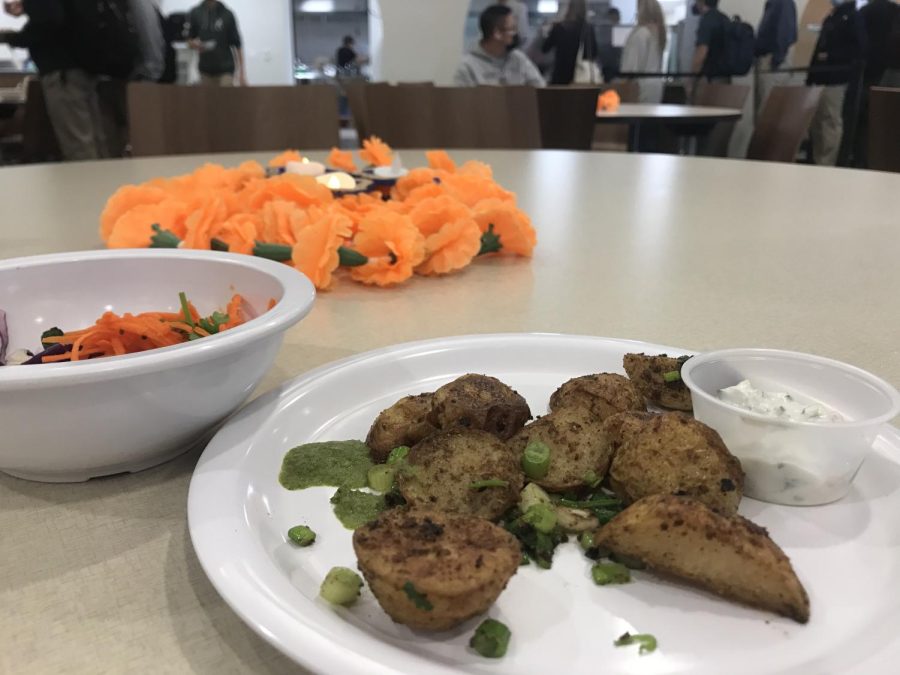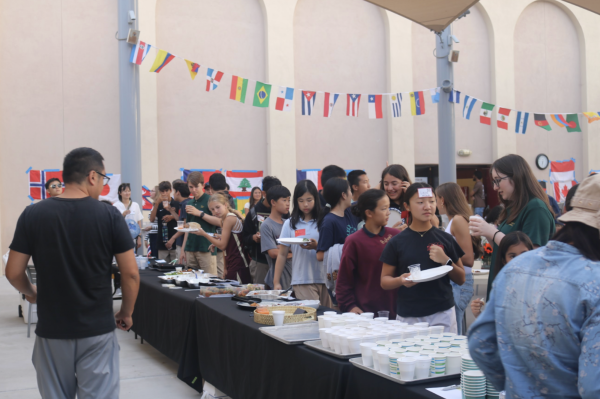Dining With Diversity
How the cafeteria promotes diversity through dishes
On November 3, the cafeteria made potatoes with an Indian twist and a pickled cabbage salad to celebrate the Indian holiday Diwali. The orange flower centerpieces are one of the many decorations that were placed around the cafeteria that day.
Bishop’s cafeteria is unique compared to standard American cafeteria food. Rather than only serving the classic dishes like burgers or cheese pizzas, the Bishop’s menu is diverse. Students line up to eat food from around the world, from countries in places like South Asia, the Middle East, and East Asia, whose dishes make regular appearances during lunch.
Exposure to different foods encourages the understanding and exploration of different cultures. Since food is a part of one’s cultural identity, the celebration of cultures means that we are also celebrating one’s identity and all people. The cafeteria, by creating those dishes, promotes and celebrates the sharing and love of different cultures.
Director of Food Services Ms. Sara Sweet works to create the cafeteria’s diverse menu. “One of the wonderful things about people coming from different places [is that] they bring different ideas, different ways of doing things,” she said. “To be able to appreciate that, to learn from each other, is a wonderful opportunity for everybody.”
Director of Diversity, Equity, Inclusion, and Justice Mr. David Thompson confirmed this: “Food certainly can be a major part of sharing culture,” he shared. Through food, a better understanding and expression of the shared dishes’ origins is fostered.
One of the many steps the cafeteria makes to ensure that dishes are portrayed accurately and to foster the appreciation Ms. Sweet mentioned is by collaborating with affinity groups. Additionally, Ms. Sweet and the cafeteria staff are always open to suggestions of dishes and feedback from the students to allow for an open and diverse representation of all opinions and identities.
Middle Eastern Student Association (MESA) leader Nadia Bitar (‘22) said that MESA plans to hold some cultural events in honor of Nowruz, also known as the Iranian new year, and Arab American History Month in order to spread their culture. “We are going to try to collaborate with the kitchen…to make some [Middle Eastern] food,” said Nadia Bitar. This collaboration would include planning lunches that featured Middle Eastern cuisine and voicing their opinions on the food that would be represented on the holiday.
For Latinx-Hispanic Heritage month (which takes place between September and October), students of Hispanic heritage wanted to share food from their culture. “Students have talked about wanting to have some of the food that they found was really important to their culture. They were thinking about what that process looks like and how they can share,” Mr. Thompson said.
Unfortunately, although LASO (Latinx-American Student Organization) tried to plan a special meal and celebration for Latinx-Hispanic Heritage month, they were advised not to due to tighter COVID protocols that were held earlier in the year during that month.
Besides working with student affinity groups, the staff also does research on the different types of food before serving the food to the school. “We’ve had the wonderful opportunity for parents to come in and show us things…there’s [also] so much on YouTube

bread on November 29, representing Italian
food and culture with a healthy twist.
, and we all read about cooking, and so we get a lot of ideas and education through those means,” Ms. Sweet said. For example, the cafeteria staff are currently working with Korean parents to learn more about their cuisine.
The cafeteria also takes time to make an authentic representation of different meals. When the cafeteria staff made a Moroccan chicken dish that required preserved lemons, they did not buy pre-preserved lemons. “Head Cook Fernando Figueroa cut open and brined a case of lemons in salt for over a month to preserve the lemons and get the lemon pickle flavor needed for the dish,” said Ms. Sweet.
During Diwali, India’s Festival of Lights, parents worked with the kitchen staff, who made potatoes with spices and other Indian food. The parent-organized celebration included loud music and dance and lines growing for the henna booth. Parents also brought in food from outside the school to add to the festivities. The cafeteria contributed to this festive environment by researching and making Indian food so that students of different cultural identities could gather in the cafeteria and experience Indian culture.
“What I really liked about [that lunch] was that it was part of a celebration of a culture that we don’t often celebrate at school,” Mr. Thompson said. East Asian Student Association (EASA) leader Katelyn Wang (‘23) shared Mr. Thompson’s opinion. “I didn’t really know it was Diwali, but [the food and celebration] really brought that spirit to the school.” She went on to explain that the Diwali celebration at school helped her become more aware and appreciate cultures other than her own.
“[Having a diverse menu] exposes people to new tastes,” Ms. Sara Sweet stated, “you are in a big community of people [and maybe] you are sitting with your friends and they’re eating something that maybe you haven’t had or you thought you didn’t like, and so you might try something because you are sitting there eating with a group of people who eat differently.”
While emphasizing the importance of the role of food in diversity, Spanish Teacher Profe. Carlos Martell remembered seeing many Japanese restaurants on his trip to Japan, but not as many establishments that served other food from other cultures. He believes that the reason why food in the United States is diverse is that the country itself is a mix of different ethnicities and identities.
He expressed his own gratitude for the cafeteria’s diverse food. “You get to have a taste of another culture…[the cafeteria food] opens a little window to taste what that other culture is,” he continued, “[Bishop’s] society is more diverse than we think, and we see that in our food.”
The cafeteria’s daily variety within the menu is also greatly appreciated by students. A range of food—from Italian subs to a Vietnamese soup called phõ—is a show of the cafeteria’s variety. When asked what his favorite dish from another culture was, Middle Eastern Student Association leader Aiden Afshar (‘24) said, “the Korean beef has always been really good.”
Another popular dish is the spring rolls that were once served. “Last year we had spring rolls…those were epic,” Katelyn remembered. Nadia’s favorite cafeteria dish from another culture is the School’s Greek food, which usually includes, but is not limited to, pita bread, tzatziki sauce, and gyro meat.
Food is a tradition, a cultural pride. The sharing of recipes and dishes which have been passed down from generation to generation allows us to learn and appreciate other affinities When that pride is shared, diverse groups of people come together and get to communicate through a universal language: the stomach.

Summer is a senior and Editor-in-Chief of The Tower. This is her fourth year on the staff and third on the editorial team, previously serving as a story...



![(from left to right) Nathaniel Hendrickson (‘31), Benjamin Hill (‘31), and Cameron Sibley (‘31) are all smiles as they pet Brady, Ben’s spotted dog, who was blessed. “[Brady] was very excited and happy to be there,” he said.](https://thebishopstower.com/wp-content/uploads/2025/10/Screenshot-2025-10-13-at-8.45.50-AM-600x449.png)


![Leia (‘30) and Sara Park (‘32) ended their combative performance with a yell known as a kiyap. Leia explained with a proud smile, “I realized this when I was little, but not many people see taekwondo every day. For me, it’s a daily occurrence, so it feels very normal…when I do [a performance] in public, everyone’s like ‘Wow, that’s really cool’. So it always reminds me how this isn’t a normal thing in other people’s lives and I think it’s really cool that I can share that.”](https://thebishopstower.com/wp-content/uploads/2025/10/Screenshot-2025-10-02-at-2.07.47-PM-600x583.png)